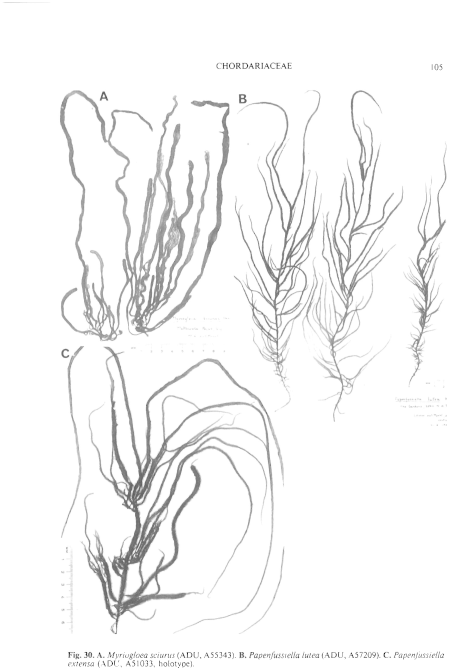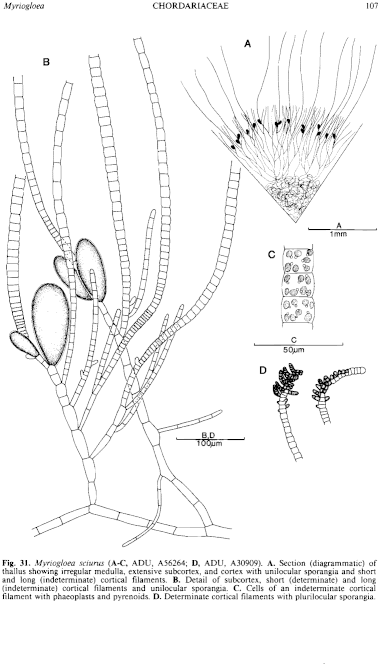|
|
|
|
|
|||||||||||
|
Electronic Flora of South Australia Species Fact Sheet
Phylum Phaeophyta – Order Chordariales – Family Chordariaceae
Selected citations: Bailey & Womersley in Womersley 1967: 233. Kuckuck 1929: 63, fig. 81. Kylin 1940: 12, figs 7, 8A. Levring 1939: 43, fig. 1E,F. Parke 1933: 29, pl. 2 fig. 8, p1.9 figs 52–56, pls 10,11 (in part - see below).
Synonym
Myriocladia sciurus Harvey 1858: p1. 58.
Thallus (Fig. 30A) dark brown, very mucoid, tomentose, simple to branched with long laterals from near the base and occasionally above, rarely with short, proliferous branches, 10–50 (–120) cm long and 3–5 (–10) mm in diameter. Basal system of juvenile plant consisting of appressed, radiating filaments of short cells 8–12 µm in diameter, producing a tuft of erect filaments. Medulla of longitudinal, more or less parallel, filaments 20–30 µm in diameter, cells L/B 4–10, which produce abundant hyphae 4–6 µm in diameter and which traverse the medulla irregularly and soon separate (and in older parts obscure) the broader, longitudinal filaments; old medulla thus largely composed of irregular, slender filaments (Fig. 31A) and often becoming hollow. Subcortex (Fig. 31A,B) of filaments which originate laterally from young medullary filaments and develop radially to the axis, forming a zone 200–600 (–900) µm broad, with branched non-pigmented cells (8–) 12–20 µm in diameter and L/B 3–8. Cortical filaments (Fig. 31A,B) dense, arising from branches of subcortical filaments, and of two lengths; determinate cortical filaments 200–400 µm and 15–30 (–40) cells long, cells 10–12 µm in diameter and L/B 1–1.5 (–2) above, 7–10 µm in diameter and L/B 2–4 below, with intercalary divisions in the upper part of the filament; indeterminate cortical filaments 1–2 mm and commonly over 80 cells long, cells (12–) 15–20 (–25) µm in diameter, L/B 0.7–1.2 near their basal meristem, becoming L/B (1–) 1.5–2 (–2.5) above. Phaeoplasts (Fig. 31C) numerous per cell, discoid, each with a prominent pyrenoid; physodes present in most cells. Phaeophycean hairs absent.
Reproduction: Plurilocular sporangia (Fig. 31D) rare, present on plants with or without unilocular sporangia, formed by subdivision of upper cells of determinate cortical filaments to give lateral, tapering, multiseriate sporangia 5–20 µm long. Unilocular sporangia (Fig. 31B) present on most plants, borne on outer subcortical cells, sessile, broadly clavate to ovoid, 60–100 (–120)1Lm long and 20–40 (–50) µm in diameter.
Type from Port Fairy, Vic; in Herb. Harvey, TCD.
Selected specimens: Wanna, S. Aust., low eulittoral ( Womersley, 21.viii.1967; ADU, A31805). West Bay, Kangaroo 1., S. Aust., lower eulittoral (Bailey, 29.x.1966; ADU, A30687). Robe, S. Aust., lower eulittoral (Womersley, 8.x.1972; ADU, A42781-"Marine Algae of southern Australia" No. 147). Apollo Bay, Vic., lower eulittoral pools (Womersley, 23.i.1967; ADU, A31752). Cape Everard, Vic., lower eulittoral (Bailey, 25.i.1967; ADU, A30909, plurilocular sporangia). Mallacoota Point, Vic., mid eulittoral (Womersley, 12.xi.1982; ADU, A55343, plurilocular with a few unilocular sporangia). Bluestone Bay, Freycinet Pen., Tas., 6 m deep (Brown, McGeary & Womersley, 4.xi.1982; ADU, A56264).
Distribution: From Point Drummond, S. Aust. to Newcastle, N.S.W. and around Tasmania.
Taxonomic notes: Myriogloea sciurus is common in the low intertidal region on wave-washed rocks, often with slight shelter but on generally rough-water coasts; it occurs from August to late February as a summer annual. M. sciurus is usually readily recognised by the slight branching, with long laterals from near the base, and the dense, dark brown tomentum of indeterminate cortical filaments.
M. sciurus was credited to New Zealand by Lindauer et al. (1961, p.226) but Nelson & Adams (1983) consider all New Zealand species belong to M. intestinalis (Harvey) Lindauer et al. and not to M. sciurus. The two species are closely related but seemingly distinct in that M. intestinalis has cells of the indeterminate cortical filaments with L/B rarely greater than 1, whereas in M. sciurus they are commonly L/B 1.5–2. Other species of Myriogloea need careful comparison with M. sciurus to clarify specific differences. Parke (1933, p.29) used material from India and South Africa, as well as dried Australian plants, in her study of "Myriogloia sciurus". The Indian material was referred by Kylin (1940, p.16) to Lerringia boergesenii Kylin, and the South African material to Myriogloea papenfussii Kylin, which is doubtfully distinct from M. sciurus.
References:
HARVEY, W.H. (1858). Phycologia Australica. Vol. I, Plates 1–60. (Reeve: London.)
KUCKUCK, P. (1929). Fragmente einer Monographie des Pheosporeen. Biol. Anst. Helgol. 17, 1–93.
KYLIN, H. (1940). Die Phaeophyceenordnung Chordariales. Acta Univ. lund. N.F. Avd. 2, 36(9), 1–67, Plates 1–8.
LEVRING, T. (1939). Über die Phaeophyceengattungen Myriogloia Kuck. und Haplogloia nov. gen. Bot. Not. 1939, 40–52.
LINDAUER, V.W., CHAPMAN, V.J. & AIKEN, M. (1961). The marine algae of New Zealand. II. Phaeophyceae. Nova Hedwigia 3, 129–350, Plates 57–97.
NELSON, W.A. & ADAMS, N.M. (1983). A taxonomic revision of the families Chordariaceae and Chordariopsidaceae (Phaeophyta) in New Zealand. N.Z. J. Bot. 21, 77–92.
OLTMANNS, F. (1922). Morphologie and Biologie der Algen. Vol. 2. (Jena.)
PARKE, M. (1933). A contribution to knowledge of the Mesogloiaceae and associated families. PubL Hartley Bot. Lab. No. 9, 1–43, Plates 1–11.
WOMERSLEY, H.B.S. (1967). A critical survey of the marine algae of southern Australia. II. Phaeophyta. Aust. J. Bot. 15, 189–270.
The Marine Benthic Flora of Southern Australia Part II complete list of references.
Publication:
Womersley, H.B.S. (14 December, 1987)
The Marine Benthic Flora of Southern Australia
Part II
©Board of the Botanic Gardens and State Herbarium, Government of South Australia
Illustrations in Womersley Part II, 1997: FIGS 30A, 31.

Figure 30 enlarge
Fig. 30. A. Myriogloea sciurus (ADU, A55343). B. Papenfussiella lutea (ADU, A57209). C. Papenfussiella extensa (ADU, A51033, holotype).

Figure 31 enlarge
Fig. 31. Myriogloea sciurus (A–C, ADU, A56264; D, ADU, A30909). A. Section (diagrammatic) of thallus showing irregular medulla, extensive subcortex, and cortex with unilocular sporangia and short and long (indeterminate) cortical filaments. B. Detail of subcortex, short (determinate) and long (indeterminate) cortical filaments and unilocular sporangia. C. Cells of an indeterminate cortical filament with phaeoplasts and pyrenoids. D. Determinate cortical filaments with plurilocular sporangia.

|
Email Contact: State Herbarium of South Australia |

|